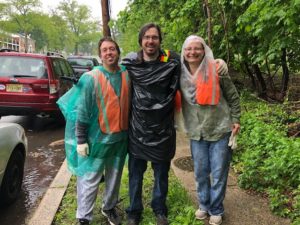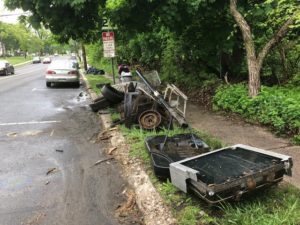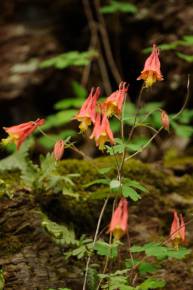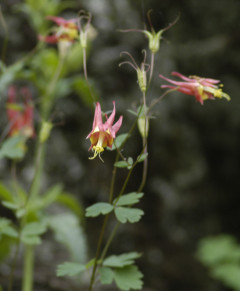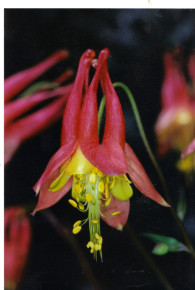Thank you volunteers!!
It was a gloomy, rainy Saturday, but on May 12, more than 150 people joined the Lower Raritan Watershed Partnership, Greater Brunswick Charter School, Esperanza Neighborhood Partnership, Friends of Mile Run Brook and Elmwood Cemetery for a multi-site community clean-up and celebration of New Brunswick’s Mile Run Brook.
Friends of Mile Run Brook
The clean-up was enlivened by our roving “Trash Troubadour” – Dave Seamon – who engaged our volunteers with song and stories as they cleaned-up the stream. Our Trash Troubadour traveled with a large sculptural bread-and-puppets style bottle (made from trash found during prior clean-ups) that clean-up volunteers covered with messages of environmental hope.

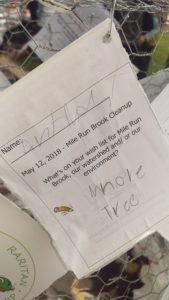
The clean-up was followed by a free community celebration and picnic in New Brunswick’s Boyd Park – with delicious contributions of dishes donated by Panico’s Brick Oven Pizza, La Poncena, Harvest Moon, Pizza Mia and Popeye’s Louisiana Kitchen.
At the end of the clean-up we joined together for a picnic and celebration, the Trash Troubadour created and performed a new song from the messages received.
Filmmaker Jessica Dotson is working on a music video story of the day – a gift for our Mile Run Brook and New Brunswick Community. But for now, click on the photo of our Trash Troubadour to enjoy a youtube video of his riverside performance:

With tremendous thanks to New Brunswick Department of Public Works, North Brunswick Department of Public Works and Rob Hughes, our Americorps Watershed Ambassador for helping with planning, coordination, supplies provision and arranging for disposal of the trash and recycling. Thanks also to the Highland Park Ecology and Environmental Group and Central Jersey Stream Team for bringing your muscle to the clean-up for the day!
Trash Collected at the Hamilton Street Site
Esperanza Neighborhood Project Volunteers!!
The Elmwood Cemetery volunteers (coordinated by the New Brunswick Environmental Commission), removed 14 bags of trash and 6 bags of recycling.
The Greater Brunswick Charter School removed approximately 1,275 pounds of trash and 720 pounds of recycling.
The Esperanza Group removed an estimated 875 pounds of trash and 390 pounds of recycling.
The Friends of the Mile Run removed about 400 pounds of trash and 210 pounds of recycling.
In addition, 20 bulk items and 6 tires were removed as well.
Collectively volunteers removed approximately 2 tons of litter and bulk items from Mile Run Brook!
THANK YOU!!
Article and photos by Joe Mish
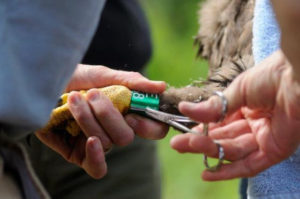
Rose gets a green aluminum band affixed to her left leg and a silver band to her right leg. Green is the band color used by NJ and silver is a federal band. Each state uses a specific color to quickly identify a banded eagle’s origin.
Over last century as the northeast bald eagle population dwindled, their image flourished as a marketing tool to brand high end merchandise. Gilded eagles sat upon flag poles in parades and auditoriums. Dollar bills and quarters bore engraved, lone eagles, wings spread and talons flared, about to attack at the least provocation.
Never did any image show more than one eagle, even though they mate for life and are dedicated parents. As a generation, we came to know eagles as powerful solitary creatures frozen in iconic poses. There was nothing to challenge that image, the skies were empty and no shadows could be seen speeding across the land. Least of all in central NJ, a land reputed to be sanitized of nature.
Awareness of man’s place in the natural world and his impact on the environment began to be studied in universities like Rutgers College of Agriculture and Environmental Science in the late 1960s, which opened the door to a new era of enlightenment and activism. Books like Silent Spring and Sand County Almanac were the seeds sown to nourish the idea humans were not apart from the cascade of life that flowed, uninterrupted, from the soil and water to apex predators, like the eagle and peregrine falcon.
Eagle restoration in NJ began in earnest in the 1980s accompanied by an ever-growing accumulation of study data gleaned by observation and scientific research. Still the view of intimate eagle relationships and social interaction remained at a sky-high level and not well published for public consumption.
Eagles kept their privacy and legacy reputation as solitary creatures intact until the advent of live cameras, genetic mapping, banding and miniature transmitters.
As far as the public is concerned, it is the live cams, set above some nests and broadcast on the internet, that provide non-stop coverage of eagle antics in the aerie to feed an insatiable voyeuristic human appetite.
The forums that accompany these spy cams generate lively conversation and together, have created a whole new audience beyond those immersed in all things nature. People who can’t tell a snow goose from a snow bunting, are now addicted a wildlife reality show.
And addictive it is, as viewers and scientists both learn what goes on behind nest walls. As voyeurs watch, they see behaviors that mimic human responses. The eagle screaming at its partner could very well be a replay of last night’s argument with their spouse, “who never listens to a word I say”.
Cumulatively, what we see are personality differences among pairs of eagles, where before we had only anecdotal observations and generalized conclusions. We knew the eagle as a solitary warrior and now we see a great raptor dedicated to its mate and offspring. When we look closely into the world of an eagle we see a glimpse of ourselves.
Locally the intrigue has been riveting, with a ringside seat to a female ingénue coming between a mated pair, a harassing hawk obliterated by an annoyed eagle and tender moments of dedicated parents doting on their precious offspring.
We watch as courting behavior evolves into mating, egg laying and alternate job sharing, as pairs relieve each other from brooding duty. We see and hear the wailing of one parent when their mate fails to return, either through injury or death. You cannot be unaffected by that sight and sound as what you experience is automatically translated into human terms.
A live cam from another state showed a female eagle covering her three, day old chicks, as a late spring snowstorm raged. That moment was tender enough but then the male positioned himself alongside the female, resting his head on her shoulder and spread his wings to shield his mate and their chicks from the heavy snowfall; our collective tears flowed.
Recently an eagle that prematurely fell from a local nest was rescued, examined and found to be in good health. Given that one parent went missing in the weeks prior to the fall and it was impossible to return the bird to the nest, a decision was made to place that eagle in another nearby nest.
Armed with the knowledge of intimate eagle behavior and demonstrated dedication to their young, fostering that young eagle was done with full confidence it would be accepted and thrive.
Only time will tell but so far, so good. Years hence, if you see a bald eagle bearing a green leg band, engraved with E68, you now know the rest of the story. Consider an eagle that was killed, June 2015, in upstate NY by a car, was banded 38 years prior! So, eagle E68, affectionately named, Rose, and her foster siblings, E66 and E67 have a good chance to be seen by your grandchildren!
Author Joe Mish has been running wild in New Jersey since childhood when he found ways to escape his mother’s watchful eyes. He continues to trek the swamps, rivers and thickets seeking to share, with the residents and visitors, all of the state’s natural beauty hidden within full view. To read more of his writing and view more of his gorgeous photographs visit Winter Bear Rising, his wordpress blog. Joe’s series “Nature on the Raritan, Hidden in Plain View” runs monthly as part of the LRWP “Voices of the Watershed” series. Writing and photos used with permission from the author.
Article and photos by Joe Mish
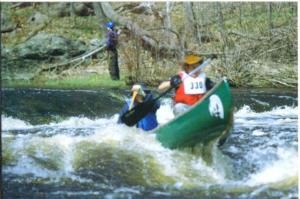
The powerful watery hand of the river reaches up in a wild mood to toss its dance partner skyward.
A canoeist might think of the river as a dance partner whose energy flow and mood sets the tone for the style of dance to be performed. A waltz, a tango or lambada are all on the river’s dance card to be enjoyed or sat out. Any paddler who wishes to partner with the river and enjoy the wide variety of watery tunes must have practiced moves, familiarity with boat and paddle and an ability to read the subtle nuance of wave patterns reflecting the structure of the hidden riverbed.
While high water and low water dances may be thoroughly enjoyed, I originally coined the term ‘river dance’ to describe the convoluted navigation required to follow the low water flow typically occurring on the South Branch during the summer.
Each year, winter ice and downed trees reshape the river bed to form new shoals, islands and channels which leave the scars and wrinkles that figure so prominently when water levels drop in the summer.
Low water and limited paddler skill do not preclude a float trip down the river as a grounded boat may be dragged across exposed shoals and shallows to deeper water.
Plodding along does not equate to river dancing but it gets the job done.
The joy of river dancing comes into play when the paddler, perhaps in a solo canoe, seeks out cuts and channels that hold just enough water to support the boat. Following the deepest water when the riverbed becomes a player in the band may mean tracing a convoluted course from one side of the river to the other. This shallow water navigation strategy is directly applicable to high, fast water flowing through boulder strewn stretches of river. Both situations require reading the wave patterns to determine the best path beyond the next immediate move.
One fast water section where I launch always has sufficient water from bank to bank for about a hundred yards. During lower water levels the left side and most of the middle of the riverbed is almost exposed and not navigable except for a narrow cut quite close to river right. As is often the case, a direct downstream approach to the deep water cut is not possible because the water directly above the cut is too shallow or has a downed tree blocking that approach. As the situation and solution is obvious from a long distance upstream there is time to gradually approach the passage at a forty-five degree angle and then straighten the boat with a quick draw to follow perfectly in the strong deep current.
Further downstream near a bend in the river, a long treeless island appears, the right side of which is navigable in a channel that runs along the opposite bank. As the channel nears the end of the island, it flattens out and disappears. The water then seeks to run at an angle across the raised center section of the riverbed. The riverbed here appears to have a profile of a typical crowned roadway and the main channel reappears to run just along the tip of the island. Crossing the riverbed from one channel to the other requires a good look at the wave patterns. If you know nothing, then just observe the differences in the wave patterns. In very shallow water they are almost indistinguishable but with practice differences will become apparent. Generally, flatter waves reflect deeper water. Or simply put, the less busy the surface of the water appears, the further above the riverbed it is. Don’t be surprised sometimes to find the water too shallow despite choosing the most favorable pathway. Crossing an ultra shallow channel as described, may require the paddler to shift their weight forward to create an absolute neutral balance in the boat to avoid a fore or aft drag. Shifting paddler weight to one side in a typical shallow V-shaped hull will often decrease the depth the hull protrudes into the water and might make the difference between stepping out and dragging the boat or barely floating by with some slight scraping.
One of the most useful skills a paddler can acquire is the ability to ferry. A ferry is a method which allows cross stream travel in swift water with minimal paddler effort.
I usually stop to do a ferry whenever fast water presents itself just because it is so much fun and feels like magic. A ferry is based on the premise that a canoe becomes invisible to the current when perfectly aligned with the water flow. A canoe can be paddled upstream and held in position without any downstream travel when the hull is parallel to the water flow. Eventually when the hull begins to angle across the current the boat will be washed downstream. The speed with which the boat is carried downstream depends on the angle of the boat to the water flow. The greater the hull angle, the greater the surface area the current has to push against. A ferry is possible when the boat is angled into the current and that angle held steady by the paddler. Very fast water requires a shallow angle to be held, the slower the water speed the greater the angle needed to perform a ferry.
Often the current speed changes as you cross the river and the boat’s position must be adjusted appropriately. The magic occurs when you realize the boat, held at the proper angle, begins to cross the current from one side to the other without any downstream travel!
A ferry can be accomplished with the bow upstream or downstream. Simply angle the upstream end of the boat in the direction of the shore you wish to reach. In very fast water you might suddenly find yourself at the precipice of a ledge with no chance of safe passage. Not to worry. Straighten the hull with any and all paddle strokes that might be applicable, hold the boat steady. Choose your angle and be amazed as your boat becomes a magic carpet to drift you above the ledge, perpendicular to the current, and on to a safe passage or convenient eddy.
Do not despair when summer water levels fall and most folks abandon the thought of paddling the local rivers. Armed with patience and agility you might try to dance with the river on her terms.
Author Joe Mish has been running wild in New Jersey since childhood when he found ways to escape his mother’s watchful eyes. He continues to trek the swamps, rivers and thickets seeking to share, with the residents and visitors, all of the state’s natural beauty hidden within full view. To read more of his writing and view more of his gorgeous photographs visit Winter Bear Rising, his wordpress blog. Joe’s series “Nature on the Raritan, Hidden in Plain View” runs monthly as part of the LRWP “Voices of the Watershed” series. Writing and photos used with permission from the author.
On Saturday May 5 several partners helped the Borough of Bound Brook inaugurate its first kayak/canoe launch site. A partnership between the Borough and New Jersey American Water (NJAW) resulted in an access agreement to allow recreational use of private land, giving paddlers a new access point to the Raritan River. The agreement between the Borough and NJAW allows the public to put their watercraft into the Raritan in an area owned by NJAW under the Queens Bridge in the Borough.
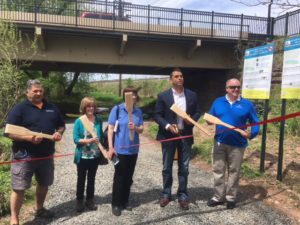
Bound Brook Borough Administrator Hector Herrera and Council President Abel Gomez were joined by representatives of South Bound Brook; Somerset County; New Jersey American Water; Pfizer on behalf of Wyeth Holdings; the Raritan Riverkeeper; National Park Service Rivers, Trails & Conservation Assistance; and members of the public for the ribbon cutting and launch ceremony on a beautiful spring day. Signs explaining how to use the access site with a map of downtown Bound Brook greeted launch users in English and Spanish.
Council President Abel Gomez noted: “This launch site for kayaks and canoes is part of a bigger plan to restore public access to the Raritan River. In 2015, the Borough’s Economic Development Advisory Committee published Riverfront Access Plan for Pedestrians and Bicyclists. This plan puts forth strategy and initiatives for a comprehensive bicycle and pedestrian network to connect downtown commercial areas with the riverfront. The launch site is another element that makes Bound Brook a destination area.”
In addition to the access to the River for paddlers, the Plan calls for the creation of a park along the waterfront from Queens Bridge to Middle Brook, including the development of a riverfront trail system for pedestrians and bicyclists using inactive rail corridor and a levee system. Raritan Riverkeeper Bill Schultz explained that the “launch site will mean that paddlers can now travel all the way from Bound Brook downstream to Perth Amboy and the Raritan Bay, about 18 miles. Raritan River recreation complements the land-based recreation currently available on the south side of the river, as part of the Delaware & Raritan Canal State Park.”
The Borough is receiving technical assistance from the National Park Service’s Rivers, Trails & Conservation Assistance Program. The NPS helped form a steering committee made of local stakeholders, including New Jersey American Water, Somerset County Planning Division, Rutgers University Edward J. Bloustein School of Planning and Public Policy, Pfizer on behalf of Wyeth Holdings, and members of the Bough’s Economic Development Advisory Committee.
The Riverfront Access Plan is available at: http://boundbrooknj.org/MasterPlan/RiverAccessPlan
For more information about the project, contact Bound Brook Borough Administrator
Hector Herrera at 732-893-8520 or hherrera@boundbrook-nj.org
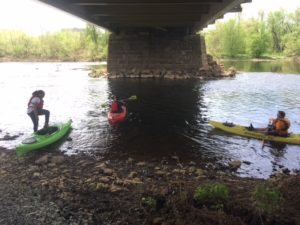
Article and photo by Hector Herrera
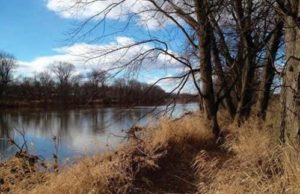
A partnership between the Borough of Bound Brook and New Jersey American Water will give kayak and canoe enthusiasts a new access point to the Raritan River. The agreement between the Borough and New Jersey American Water allows the public to put their watercraft into the River in an area owned by NJAW under the Queens Bridge in the Borough.
“This launch site for kayaks and canoes is part of a bigger plan to restore public access to the Raritan River. In 2015, the Borough’s Economic Development Advisory Committee published Riverfront Access Plan for Pedestrians and Bicyclists,” said Bound Brook Council President Abel Gomez.
“This plan puts forth strategy and initiatives for a comprehensive bicycle and pedestrian network to connect downtown commercial areas with the riverfront. This launch site is another element that makes Bound Brook a destination area.”
In addition to the access to the River for kayaks and canoes, the Plan calls for an open space along the waterfront, from Queens Bridge to Middle Brook. This would include the formalization of a Bound Brook Riverfront Trail System for pedestrians and bicycles and a creation of a riverfront park. The Plan can be found by going to this url: http://boundbrook-nj.org/MasterPlan/RiverAccessPlan
The Borough received a technical assistance award from the National Park Service’s Rivers, Trails & Conservation Assistance Program in 2017 and 2018. The NPS helped form a steering committee made of local stakeholders including New Jersey American Water, Somerset County Planning Division, Rutgers University Edward J. Bloustein School of Planning and Public Policy, Pfizer, and members of the Borough’s Economic Development Advisory Committee.
The Borough of Bound Brook and New Jersey American Water will formally open Bound Brook’s Riverfront Access Launch at noon on Saturday, May 5, 2018. The launch is located under the Queens Bridge in Bound Brook. RSVP required.
For more information about the kayak and canoe launch site or to RSVP for the ribbon cutting ceremony, contact Bound Brook Borough Administrator Hector Herrera 732-893-8520.
Article and photos by Joe Mish
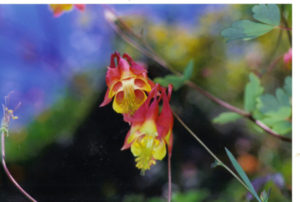
Looking up into the columbine flower’s mouth, I see a dove with wings spread or an angel. This diminutive wild flower is found in isolated patches among the red shale cliffs that line the South Branch. Who knew, other than hummingbirds, that such a treasured crown jewel was hidden along our river.
The red shale cliffs interrupt pasture and field along the South Branch to stand as an unchanging reference point, immune to progress and raging spring floods that swirl around them.
The exposed cliff face is characterized by a jagged appearance, with sections of smooth rock face the exception. Ancient floods have scoured rounded contours into the soft shale, to form shallow caves, nooks, crannies and alcoves. Like a human face with striking character, the cliffs beg more than a casual glance.
I cannot paddle by without desperately searching the high cliff face for ancient etchings or a petroglyph. Travelers from earliest times could not have passed up an opportunity to scribe their name or draw their hunting or fishing trophies into the smoother areas of these red shale sketchpads. It would be against human nature to leave no sign.
Unexpectedly, what I have found among the craggy shale cliffs is a species of native wildflower that begins to bloom in late April through May. Wild columbine is not found anywhere else, except in the crevices of the prominent shale outcroppings along the river.
Columbine is a finely structured red and yellow flower, in the shape of a crown with five distinct tubular projections. The openings of the five separate passages are shrouded in a common vestibule. Several stalks arise from one clump, one flower to a stem, opening faces downward. The plant is not found in profusion, just in scattered, isolated patches.
There are many commercial cultivars and species of columbine, so to be clear, the wild native columbine is Aquilegia columbine. The derivative of the name is interesting as, ‘Aquila’, is Latin for eagle, and columbine references the family designation of doves. Early taxonomists saw characteristics of both in the flower. It is said the ‘spurs’ resemble the open talons of a raptor and the face of the flower, a nest of doves. To me the spurs that project to form the crown remind me of the reversed leg joint of a grasshopper when viewed from a certain angle and looking up into the mouth of the flower, I see the form of a single dove with wings spread.
The columbine flower produces tiny round black seeds in late May that are indistinguishable from poppy seeds. Though the columbine blooms about the time the first migrating hummingbirds show up, I have yet to catch a hummer dining on the flowers but surely some returning hummers have the plants marked on their GPS.
How and when columbine first found anchorage in these cliffs is a mystery. In the absence of its known origins, I prefer to think of these flowers as inheritance from an ancient legacy of primitive plants. The first of which relied on wind for propagation and then, as if by the hand of an engineer, designed shape, color and form to take advantage of insect pollinators and local soil conditions. Could it be that flowers intelligently made use of the cliffs to mark their presence through the centuries where humans left no trace?
Wild columbine are the crown jewels hidden among the cliffs, that appear in the spring for a brief moment to enrich both pollinators and humans who stumble upon them.
Author Joe Mish has been running wild in New Jersey since childhood when he found ways to escape his mother’s watchful eyes. He continues to trek the swamps, rivers and thickets seeking to share, with the residents and visitors, all of the state’s natural beauty hidden within full view. To read more of his writing and view more of his gorgeous photographs visit Winter Bear Rising, his wordpress blog. Joe’s series “Nature on the Raritan, Hidden in Plain View” runs monthly as part of the LRWP “Voices of the Watershed” series. Writing and photos used with permission from the author.
Article and photos by Joe Mish
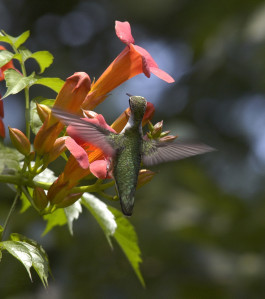
A hummingbird and orange trumpet flower engage in an evolutionary dance of equal partnership that has lasted for eons. The flower not only took advantage of an array of pollinators but also stole the heart of man who would seek to propagate flowers far beyond their natural range and ability to survive.
A name logically follows the existence of an idea, a person, place or a thing and forever provides an instant reference, complete with assigned identifiable characteristics. So before there was a month named May, a segment of time existed in nature where birth and bloom dominated the season.
The mythology from which the name of May arose was based on the same natural observations seen today. Stories of the stars and the gods became the reference points displayed on the night sky overhead projector to help explain observed phenomenon. The poetic phrase, “April showers bring May flowers” provides information sufficient enough for most people to understand the season. Instead of placing flowers at the altar of the goddess Maia we now send flowers to our mothers on a day designated to show her our appreciation, same story, different day.
Going back to the time before May, can you imagine discovering the first flower ever to bloom? In retrospect it would have meant that some plant had evolved to take advantage of a new method of pollination that relied on insects rather than wind. At the time of discovery, however, the moment had to be absolutely magical. Here was something so different in structure, color, scent and profusion that it instantly intensified a fledgling human emotion that speaks to the appreciation of beauty. The flower not only took advantage of insect pollinators but at that moment stole the heart of man who would later seek to propagate flowers far beyond their natural range and ability to survive.
Watching a rambunctious fox pup at a distance, I saw what appeared to be orange pollen on its solid black nose. As the pup was playing around the daylilies I imagined he stuck his nose inside a funnel shaped orange flower, designed for bees and hummingbirds, to come away with the telltale signs of brightly colored pollen grains. If he sniffed a few more flowers he actually became the “bee” and a willing, if not random, participant in asexual reproduction. The part that serendipity plays in nature and science can never be underestimated and its potential never unappreciated when unprecedented success results.
Fox pups are not the only pollinators unknowingly pressed into service by the ingenious evolutionary design of flowers. It is a laugh riot, for some reason, to see a dusting of yellow or orange pollen on the nose of a child or adult who sniffs a flower in pursuit of its scent. Eyes closed, as if about to plant a kiss, the human pollinator presses forward until nose touches stamen.
The entire event, so instinctive and innocently conducted, that the “bee” comes away unaware of its role in the evolutionary drama of species reproduction and survival. A kind friend will of course bring attention to the dusting of pollen left by such an intimate encounter and be trusted to address it discreetly.
Bees of all kind have ‘pollen baskets’ on their back legs which hold an accumulation of pollen grains that appear as large colorful round beads on opposite back legs. Watch one of those big furry yellow and black bees and you can easily see the lumps of colorful pollen that varies from flower to flower.
Paddling along the south branch, wild columbine can now be seen in select places on north and west facing red shale cliffs. These delicate plants grow from roots wedged between the layered red shale well above the surface of the water. The reddish pink tubular flowers with a common yellow center resemble a group of ice cream cones joined to form a common opening which leads to several individual tails. This structure encourages contact with the centrally located pollen that has to be brushed against in order to reach several sources of nectar located in each tail. This flower must have had a hummingbird sitting on the design team who decided not only the flowers structure but the time the flower was set to bloom. Hummers arriving in early spring from Mexico and Central America have a ready source of food to replenish the energy spent in their annual migration north.
Consider the greatest mayflower of all and the part it played in another notable migration. The “Mayflower”, was a ship that sailed to our shores bearing its human pollen to establish new life on the North American continent The ship, so named by unknown whimsy and intended as a supply barge, grew to evolve much as early flowers did into an effective delivery system directed by nothing more than chance. Like a flower it bloomed, spread its pollen and ‘died back’ soon after returning to England.
May apples, Virginia bluebells, trout lilies, trillium, jack-in-the pulpits and spring beauties are a small sample of local May flowers that represent the spectrum of a floral legacy whose genealogy traces back to the earliest flowers. Consider that flowers are living things that in some magical way recruited man to further their propagation in exchange for a glimpse of eternal beauty, dreams and imagination to expand the universe of human potential with unbounded creativity and expression.
Author Joe Mish has been running wild in New Jersey since childhood when he found ways to escape his mother’s watchful eyes. He continues to trek the swamps, rivers and thickets seeking to share, with the residents and visitors, all of the state’s natural beauty hidden within full view. To read more of his writing and view more of his gorgeous photographs visit Winter Bear Rising, his wordpress blog. Joe’s series “Nature on the Raritan, Hidden in Plain View” runs monthly as part of the LRWP “Voices of the Watershed” series. Writing and photos used with permission from the author.
Article and photos by Joe Sapia
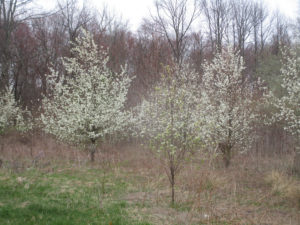
Callery pear trees taking over a field in Monroe, Middlesex County.
CALLERY PEAR TREES: Have you noticed the trees of blooming white flowers in abundance during your travels? Pretty? As we drive by them, yes. But take a closer look, these non-native, but once popular ornamentals, have large thorns, have week branches, and grow thickly. This thick growth prohibits beneficial native plant life from growing. Calleries cross-pollinate easily and produce small pears, which birds eat and, then, poop seeds through the countryside — resulting in more calleries. Enjoy the view and learn from them — that is probably the only good I can say about them.
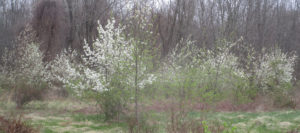
Callery pear trees along Route 130 in East Windsor, Mercer County.

A closeup of callery pears in Monroe, Middlesex County.
HEAVY RAIN…: The Jersey Midlands got clobbered with rain on the Sunday-Monday overnight and Monday, April 15-16 and 16. The National Weather Service reports the following rainfall totals in Midlands counties, although these reported records may not be complete records:
Burlington: 1.94 inches at Joint Base McGuire Dix Lakehurst to 2.50 at Southampton.
Hunterdon: 2.34 at Lebanon to 2.51 at Readington.
Mercer: 2.33 at Trenton-Mercer Airport.
Middlesex: No reading available.
Monmouth: 3.17 at Wayside.
Ocean: No reading available.
Somerset: 2.20 at Middlebush to 2.83 in the Hillsborough area.
Bucks County, Pennsylvania: 2.85 at Doylestown Airport.
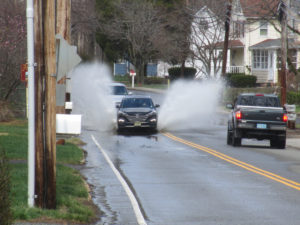
Flooding at Saw Mill Brook in Helmetta, Middlesex County.
…AND WIND: On Monday, April 16, besides getting hit hard by rain, the Jersey Midlands got pretty good winds. According to the nj.com website, strong winds were recorded at:
Monmouth County: 47 miles per hour at Sea Girt.
Ocean County: 51 miles per hour at Tuckerton and Joint Base McGuire Dix Lakehurst.
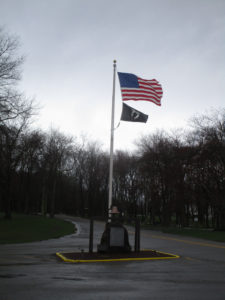
The wind whips these flags at Thompson Park on the boundary of Jamesburg and Monroe in Middlesex County on Monday, April 16.

“Jamesburg Lake” (properly Lake Manalapan) at Thompson Park on the boundary of Jamesburg and Monroe, Middlesex County, is wind-driven Monday, April 16.
GROUNDHOG IN THE WATER: I do not think of ground hogs, “Marmota monax,” and water going together. But I spooked one near Manalapan Brook. A hole dug under a tree was flooded, but the ground hog fled me, into the flooded hole. At 61-years-old, all my life in these Pine Barrens around Helmetta, I still learn.
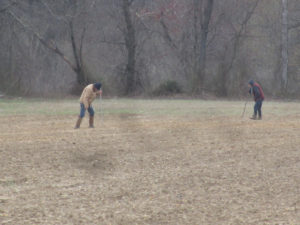
Two women searching for American Indian artifacts in a farm field on the Cranbury-Plainsboro boundary, Middlesex County.
SNOW: I received a report of snow falling Tuesday, April 17, in the Cranbury-Plainsboro area of Middlesex County. Since the winter of 1995-1996, this would be the latest snowfall I am aware of in South Middlesex County. Previously, I knew of April 16 in 2007. This season, I recorded 42.5 inches at my home in Monroe, Middlesex County; Normal, based at New Brunswick about 7.5 miles away, would be about 26 inches. Basically, half of this season’s snow did not fall until March 2 or later.
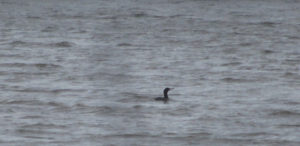
A double-crested cormorant, “Phalacrocorax auritus,” on “Jamesburg Lake” (properly Lake Manalapan) on the boundary of Jamesburg and Monroe, Middlesex County.
SHAD RUN: I ran into Don Kamienski, a field editor for The Fisherman magazine, at this year’s Outdoors Writer’s Workshop, sponsored by the state Division of Fish and Wildlife. Don, who lives along the Delaware River in Burlington County, told me the shad were already running up the river. The annual Shad Fest in Lambertville, Hunterdon County, is Saturday and Sunday, April 28 and 29. More information is available at http://www.shadfest.com.

Shad Fest, 2011 — Various festival posters and one of the artists involved.
BEWARE THE LANDSCAPER: As it warms and we get into our yards and gardens, beware of hiring landscapers or gardeners. Have some reasonable faith in them. For example, I see way too much “volcano” mulching, rather than the proper “doughnut” mulching. The buildup of volcano mulching invites fungus into the mulch and disease into the tree. (Why mulch at all?) Also, I see white rock circles around trees; It just heats up the tree. Another recent sighting was a lawn treatment of topsoil on top of old lawn, then a seeding on top of the topsoil; One, it is the wrong time of year to properly plant a lawn and, two, why not remove the old lawn and aerate? Also, topsoil is not regulated, so try to make sure you know what you are getting.
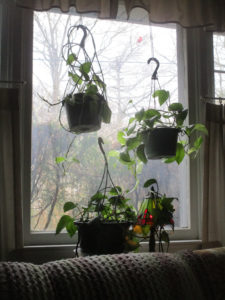
Houseplants in the living room window in my house in Monroe, Middlesex County. A cardinal, “Cardinalis cardinalis,” perched in a tree outside the window.
GOLDFINCHES, SKUNK CABBAGE, ETC.: Another sign of spring is the yellowing of male eastern goldfinches, “Spinus tristis.” “Spring males are brilliant yellow and shiny black with a bit of white,” according to Cornell University’s All About Birds website. “Females and all winter birds are more dull, but identifiable by their conical bill; pointed, notched tail; wingbars; and lack of streaking. …The brightening yellow of male goldfinches each spring is one welcome mark of approaching warm months.” This species is the New Jersey state bird. And skunk cabbage, “Symplocarpus foetidus,” is greening up in wetlands.
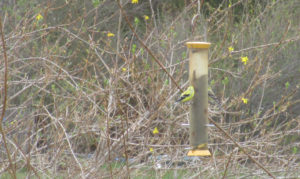
Two eastern goldfinches, the colorful male on the left and the duller female on the right, on my backyard finch feeder in Monroe, Middlesex County.
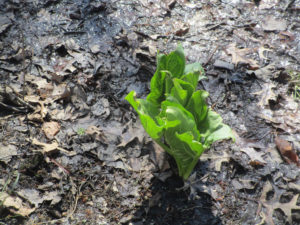
Skunk cabbage in the Millstone River floodplain on the boundary of Cranbury and Plainsboro, Middlesex County.
TONY’S MARKET: For the first time this season, I visited one of my favorite places, Tony’s Farm and Garden Center in Robbinsville, Mercer County. At Tony’s, I usually buy house plants — On this trip, I picked up a wandering Jew and a fuschia — house plant supplies, tomato plants, seeds, and perhaps other odds and ends. I have been a Tony’s customer for 25 or so years. Also, a trip to Tony’s includes me walking through the greenhouses, shooting photographs. Many thanks to the Ciaccio family. I normally deal with Tony, a third generation of the family. (My other two regular nursery stops are Krygier’s in South Brunswick, Middlesex County, and Ferris Farms Garden Center in East Brunswick, Middlesex County. All three are courteous and very helpful.)

Blooming flowers at Tony’s Farm and Garden Center in Robbinsville, Mercer County.
DRIVE-BY NATURALIST: I was driving to a Monmouth County section of the state’s Assunpink Wildlife Managment Area to attend the annual Outdoor Writer’s Workshop, sponsored by the state Division of Fish and Wildlife. While driving on Route 539 in East Windsor, Mercer County, a male northern harrier, “Circus hudsonius,” flew only a few feet off the ground and only a few feet in front of my Jeep, crossing my path from left to right. This sleek hawk is one of my favorite birds of prey. To see one close-up, if only only a glimpse, is a sight. Because it was a quick-happening event, I was unable to photograph the harrier.
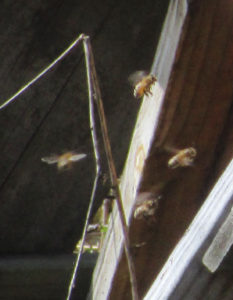
Pollinators, honeybees on the Kiesler farm along the boundary of Cranbury and Plainsboro, Middlesex County.
OUTDOOR WRITER’S WORKSHOP: As a journalist, I have been attending the state Outdoor Writer’s Workshop, sponsored by the New Jersey Division of Fish and Wildlife, on and off for about 30 years. I am a little off my turf because it is basically attended by hunting and fishing writers, rather than naturalists such as me, but the talks are informative. This year, I was able to catch the welcome by Larry Herrighty, director of Fish and Wildlife; Paulette Nelson, assistant director, on “Recovering America’s Wildlife Act,”; Ross Shramko’s “Results of the Strocked Trout Movement Study in Flat Brook”; and Sharon Petzinger’s “Songbird Response to Forest Management in Northwestern New Jersey.” Many thanks to Al Ivany, chief of Fish and Wildlife’s Office of Wildlife Education and Information, for inviting me every year. The lunch, catered by Mastoris Diner-Restaurant, one of my old hangouts in Bordentown Township, Burlington County, is a treat. (Disclosure: Beginning a few months ago, I became a Fish and Wildlife volunteer, primarily keeping tabs on the Upper Millstone River bald eagle, “Haliaeetus leucocephalus,” nest on the boundary of Mercer and Middlesex counties.)
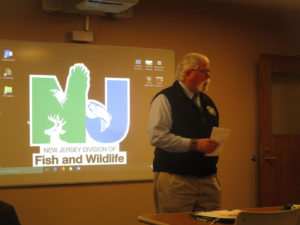
Larry Herrighty, director of the state Division of Fish and Wildlife, welcome attendees to the 2018 Outdoor Writer’s Workshop.
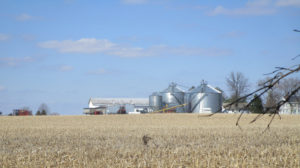
A vanishing scene of farmland, here on the Cranbury-Plainsboro boundary of Middlesex County.
VOICES FROM AFIELD, FRANK ULATOWSKI: Frank Ulatowski, an outdoorsman-friend from Manalapan-Englishtown, Monmouth County, is looking to get rid of circa late 1930s-early 1940s Allis Chalmers tractor. In its deteriorated condition, it probably would be best used for parts. Frank is reachable at Frank’s Auto Repairs in Manalapan-Englishtown, telephone 732-446-7616.
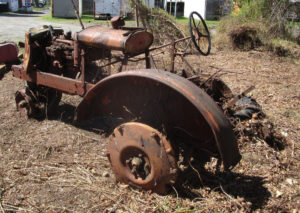
The circa late 1930s-early 19402 Allis Chalmers tractor in Manalapan-Englishtown, Monmouth County.
SKY PHOTOS: This week’s sky photos are from the areas of Helmetta, Monroe, Cranbury, Plainsboro, South Brunswick, and East Brunswick in Middlesex County; Upper Freehold in Monmouth County; and East Windsor and West Windsor in Mercer County.
A night view from my backyard in Monroe, Middlesex County.
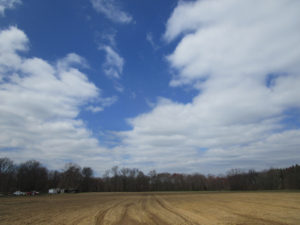
The Kiesler farm on the boundary of Cranbury and Plainsboro in Middlesex County and East Windsor, Mercer County.
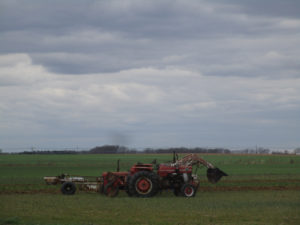
The Kiesler farm looking toward the Cranbury, Middlesex County, side.
The Kiesler farm on the boundary of Cranbury and Plainsboro, Middlesex County, looking toward Grover’s Mill, Mercer County.

Along the Millstone River on the boundary of Plainsboro and Cranbury on the Middlesex County side and East Windsor and West Windsor on the Mercer County side.
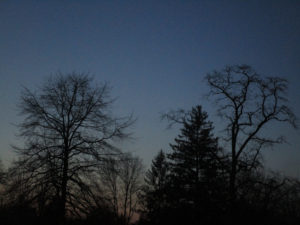
From my backyard in Monroe, Middlesex County.
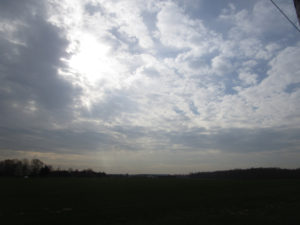
Sky over the cuesta geologic formation in Upper Freehold, Monmouth County.
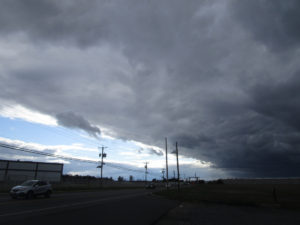
South Brunswick Middlesex County.
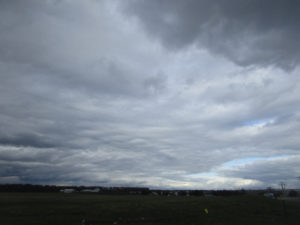
South Brunswick, Middlesex County.
Over a swamp hardwood forest on the boundary of Helmetta and East Brunswick, Middlesex County, in the Pine Barrens around Helmetta.
SUNRISE AND SUNSET: For the week of Sunday, April 22, to Saturday, April 28, the sun will rise about 6:10 to 6 a.m. and set about 7:45 to 7:50 p.m. For the week of Sunday, April 29, to Saturday, May 5, the sun will rise about 6 to 5:50 a.m. and set about 7:50 to 7:55 p.m.
NIGHT SKY: The next full moon is April 29, the Sprouting Grass Full Moon.

The crescent moon and the planet Venus, from my backyard in Monroe, Middlesex County.
ATLANTIC OCEAN TEMPERATURE: The Atlantic Ocean temperature off New Jersey was about 51 degrees.
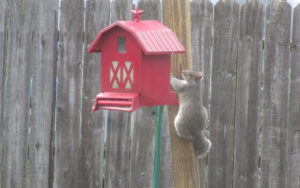
A squirrel, “Sciurus carolinesis,” at my backyard bird feeder in Monroe, Middlesex County.
WEATHER: The National Weather Service office serving the Jersey Midlands is at https://www.weather.gov/phi/.
UPCOMING:
April 28, Saturday, 10 a.m. to 4 p.m., Middlesex County, New Brunswick: Rutgers University Ag Field Day, Cook Campus, Route 1 and Ryders Lane. More information is available at website http://agfieldday.rutgers.edu.
April 28 and 29, Saturday and Sunday, Hunterdon County, Lambertville: Shad Fest event of environmentalism, entertainment, food, crafts. More information is available at http://www.shadfest.com.
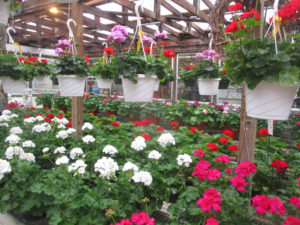
Inside the greenhouse at Tony’s Farm and Garden Center in Robbinsville, Mercer County.
REDUCING MY CARBON FOOTPRINT: As I awoke one morning, I listened to a radio broadcast about reducing one’s carbon footprint. I thought, Where am I failing to be an environmentalist? My answer is I drive too much, probably in the 20,000 miles-per-year range. I should work on this. Well, a few hours later, my Jeep was in the shop again for an ongoing clutch-dashboard area problem. Several weeks ago, I had no Jeep for 10 days — and survived quite well, walking and bicycling. So, here we go again. Fortunately, this is my slow time of year for work and with the little work I have this time of year, I can survive without a motor vehicle — I hope. Which leads me to a related story…
…BICYCLING: Without my Jeep, I bicycled from my Monroe house, through Helmetta, to Spotswood, all in Middlesex County, for breakfast. On my way back, I stopped at Timmy Mechkowski’s farmette in Helmetta. Timmy has a woodcutting operation there and I needed one log for the woodstove Timmy gave me. I grabbed the wood, tied it to rack of my second-hand, but lovingly trusty, circa 1980 Schwinn Collegiate coaster bicycle. Chris, the pizza delivery woman, saw my parked bicycle with the firewood and thought, Who would do something like this? Then, she saw it was my bike and she added, Now, it makes sense. I am like the “Log Lady” on the old Twin Peaks television show…

My coaster bicycle hauling firewood.
BURNING THE LOG: After watching on television my Toronto Maple Leafs beat the Boston Bruins is a National Hockey League playoff game, I went to my woodstove in my garden and threw in the log. I figured I would hang out under the stars on a cool night with a warm woodstove. Well, I gave up that idea when I realized I was smoking out the neighborhood. I guess the log was too wet. So, I watered down the fire and called it a night.

The woodstove in my garden with the log on top.
Joe Sapia, 61, is a lifelong resident of Monroe — in South Middlesex County, where his maternal family settled more than 100 years ago. He is a Pine Barrens naturalist and an organic gardener of vegetables and fruit, along with zinnias and roses. He loves the Delaware River north of Trenton and Piedmont, too.
He draws inspiration on the Pine Barrens around Helmetta from his mother, Sophie Onda Sapia, who lived her whole life in these Pines, and his Polish-immigrant grandmother, Annie Poznanski Onda.
He gardens the same backyard plot as did his Grandma Annie and Italian-American father, Joe Sr. Both are inspirations for his food gardening. Ma inspires his rose gardening.
Joe is a semi-retired print journalist of almost 40 years. His work also is at @JosephSapia on Twitter.com, along with The Jersey Midlands page on Facebook.com on the Jersey Midlands page.
Copyright 2018 by Joseph Sapia
Article and photos by Joe Sapia
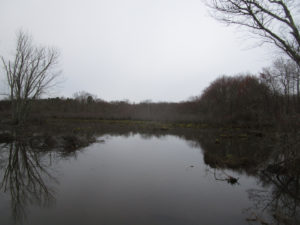
Matchaponix Brook near Englishtown Market in Manalapan, Monmouth County. This section of the brook is both diamond and rough — a beautiful natural world fighting the nonpoint-source pollution along Route 527. Brook in the foreground, swamp hardwood forest in the near background, and in the left of the far background, pitch pine trees of the Spotswood Outlier, disconnected from the main section of the Pine Barrens to the south.
MATCHAPONIX BROOK AT ROUTE 527: I am 61-years-old and have been crossing Matchaponix Brook at Englishtown Market in Manalapan, Monmouth County, since as far back as I can remember. Yet I never gave much thought to the natural world here — until Englishtown outdoorsman Gary Forman relayed information to me through our mutual friend, outdoorsman Frank Ulatowski. This is the beginning of Matchaponix Brook, formed by the joining of Weamaconk Creek and McGellairds Brook. When I stopped by this week, I was amazed. Step only a few feet away from busy Route 527 and one is in a beautiful natural world of brook; swamp hardwood forest; a lodge of beaver, “Castor canadensis”; mallards, “Anas platyrhynchos”; great blue heron, “Ardea herodias”; and the telltale pitch pine, “Pinus rigida,” of the Pine Barrens because this is part of the Pines’s disconnected Spotswood Outlier. Probably plenty more that I did not notice. Unfortunately, I did notice the nonpoint-source pollution — garbage gathering in Matchaponix Brook. Take away this garbage and the busyness of Route 527 and I was in a wonderful natural world. Again, we should keep our eyes open because the natural world is around us, even if we taint it.
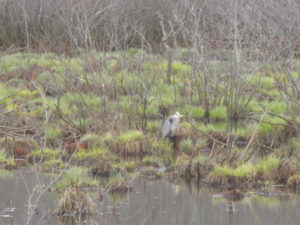
A great blue heron on Matchaponix Brook in Manalapan, Monmouth County.
AS BEAUTIFUL AS MATCHAPONIX BROOK IS AT ROUTE 527…: Nonpoint-source pollution — basically debris, such as litter or materials blown offsite, with no specific origin — is a major problem in our world. Simply look at litter along a road or, in this case, gathered in Matchaponix Brook at Route 527 in Manalapan, Monmouth County. Generally, the source of this garbage appears to be debris that drains into the brook and Route 527 littering.
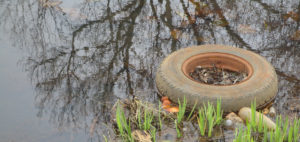
Garbage in Matchaponix Brook at Route 527 in Manalapan, Monmouth County.
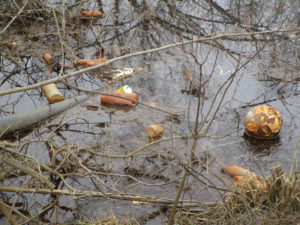
Garbage in Matchaponix Brook at Route 527 in Manalapan, Monmouth County.
MATCHAPONIX BROOK: In the Englishtown area of Monmouth County, Weamaconk Creek and McGellairds Brook join to form Matchaponix Brook. The brook then flows for about 5 miles, as the crow flies, to the north and merges with Manalapan Brook to form the South River on the boundary of Monroe, Spotswood, and Old Bridge in Middlesex County. “Matchaponix” is a Lenni Lenape Indian word for “land of bad bread,” or land where corn does not grow well. I speculate this name comes from the Matchaponix Brook area being in the Spotswood Outlier of the Pine Barrens, or an area of sandy soil not conducive to growing corn or other conventional crops. (Conversely, “Manalapan” means “land of good bread.” Manalapan Brook begins and runs for miles in a non-Pine Barrens area, or an area of darker, gravelly soil that is good for growing corn.)
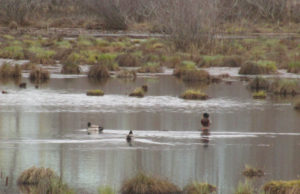
Mallards on Matchaponix Brook in Manalapan, Monmouth County.
SPRING SPRINGING: People are fishing. Listen in the early morning and you will likely hear birds singing. Look at a woods and you likely will see the red buds of trees. Flowers are blooming in gardens. Nature is coming alive with spring.
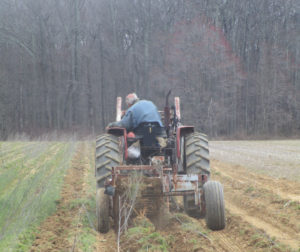
Warren Kiesler churns up horseradish plants on his farm in Cranbury, Middlesex County. To the right of the tractor in the background, notice the tree budding.

An angler at “Jamesburg Lake’ (properly “Lake Manalapan”) on the boundary of Jamesburg and Monroe, Middlesex County.
ROBINS IN THE YARD: With the coming of spring-like weather, it means the likelihood of seeing robins, “Turdus migratorius,” in our yards. I have noticed more of them around my yard in Monroe, Middlesex County. This week, I watched a robin pull a worm from my garden. “Although robins are considered harbingers of spring, many American Robins spend the whole winter in their breeding range,” according to Cornell University’s All About Birds website. “But because they spend more time roosting in trees and less time in your yard, you’re much less likely to see them.” As the weather warms and nature comes alive, they move to yards because of the availability of such things as worms. “American Robins are common sights on lawns across North America, where you often see them tugging earthworms out of the ground,” according to the Cornell website.
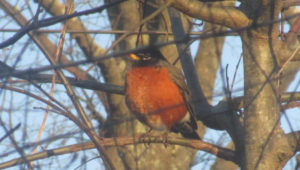
A robin in the shrubs of my front yard in Monroe, Middlesex County.
HORSERADISH FARMING: With the collapse of newspapers and, in turn, the collapse of my approximately 35 years as a reporter – basically from 21-years-old when I got my journalism degree to 55-years-old – I am always looking for work. Over those 5-plus years, I have been a part-time staff writer on a weekly paper, freelance writer, writing teacher, security guard. Security guarding, which I did during my college years and resumed these years later, now takes me from a Central Jersey professional park to the perimeter around foreign cargo ships where Maryland’s Patapsco River meets Chesapeake Bay. As I like to say, I have the best syntax at the Baltimore docks and am the only employee of Rutgers University’s Plangere Writing Center that wears a hard hat on his other job. This week, at 61-years-old, add laborer at the Kiesler horseradish farm to my resume.
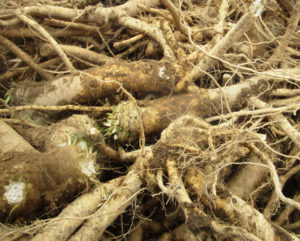
Harvested horseradish on Kiesler farm in Cranbury, Middlesex County.
SNOWBIRDS GOING, GOING…: When will “snowbirds” — juncos, “Junco hyemalis” — be gone for the season? Based on field notes I have kept over the years, they should be leaving Monroe, Middlesex County, any day now to about April 25 or so. They will head to high ground, as close as North Jersey or Pennsylvania or as far as Canada. Then, I will see them again around the yard about mid-October to early November.
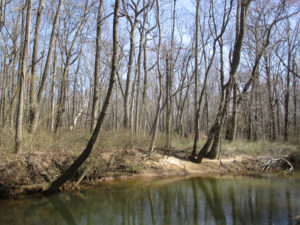
Manalapan Brook in the section of Monroe between Helmetta and Jamesburg, Middlesex County.
IN MY GARDEN: I finished the planting of the early spring crop — Kaleidoscope Blend Carrots, Touchon Heirloom Carrots, Bloomsdale Long-Standing Heirloom Spinach, Early Wonder Heirloom Beets, and Salad Bowl Lettuce, all Burpee products.
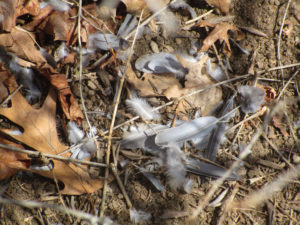
I found this in my garden. Something got this bird, the remains possible those of a mockingbird, “Mimus polyglottos.”
YARDWORK: I tackled the first yardwork of the season, working the front yard. I trimmed trees and prepared soil to plant zinnia and warm-season vegetables. The latter is a continuation of my plan to make my one-quarter-acre yard as productive as possible. With that idea, I am trying to minimize a generally unproductive lawn as much as possible.
PRINCETON ENVIRONMENTAL FILM FESTIVAL: I attended the annual Princeton Envirionmental Film Festival, seeing part of the “Evolution of Organic” movie and the entire “Seed to Seed” movie, both about organic farming. I also got to see the talk of Dr. Joe Heckman — organic farmer, a member of the board of directors of Northeast Organic Farming Association of New Jersey, and Rutgers University soil scientist — after the showing of the “Evolution of Organic” and got to socialize with Joe. (Joe and his wife, Joyce Goletz Heckman, own Neshanic Pastures farm in East Amwell, Hunterdon County. Joyce and I are childhood friends from Monroe, Middlesex County.)

Awaiting a movie at the Princeton Environmental Film Festival.

Dr. Joe Heckman, who spoke on organic farming at the Princeton Environmental Film Festival. Joe is an organic farmer, a member of the board of directors of Northeast Organic Farming Association of New Jersey, and Rutgers University soil scientist.
UPPER MILLSTONE RIVER EAGLES: We are pretty sure the nest of bald eagles, “Haliaeetus leucocephalus,” on the Upper Millstone River on the boundary of Mercer and Middlesex counties, has one eaglet in it. The baby should fledge in early to mid-May or the early end to early June on the far end. Then, the family should stay together in the area. After fledging, the young eagle or eagles should stay in the area until about early September to early December. (The bald eagle remains in New Jersey an “endangered” breeder – that is, in immediate jeopardy as a breeder – and “threatened” in general – that is, in danger of becoming “endangered” if conditions deteriorate.)
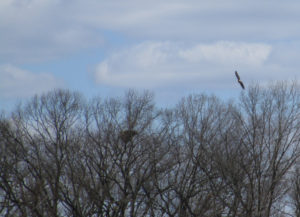
An adult bald eagle landing on the Upper Millstone River nest.
GARDEN WRITING: A great pleasure of mine is to be back at the Princeton Adult School this semester, again teaching non-fiction writing. In the past, I have taught the essay and the vignette. This semester, the course is called “Garden Writing,” but is really about gardens, the outdoors, or nature. Because of its title, the course has drawn a class of passionate gardeners. This passion inspires wonderful stories. Just this week, I have read papers about dandelions, beginning spring plantings indoors, tomatoes and their guests of the hornworm and Braconid wasp. The dozen or so in this class make it a joy to teach.
THINGS THAT DO NOT BELONG: Just because something is outdoorsy does not mean it belongs everywhere in the outdoors world. On the Millstone River on the boundary of East Windsor, Mercer County, and Cranbury, Middlesex County, I noticed ornamental daffodils growing in the river floodplain. I suspect these were purposely planted or they grew from waste soil. They looked pretty along the river, but they are a non-natives that do not belong there.
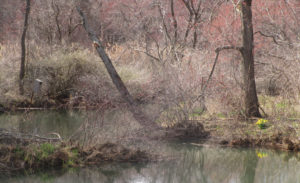
These daffodils look pretty blooming along the Millstone River on the boundary of Cranbury, Middlesex County, and East Windsor, Mercer County. But they are ornamentals that do not belong in the wild.
SKY PHOTOS: This week’s sky photos are from Monroe, Cranbury and Plainsboro, all in Middlesex County.
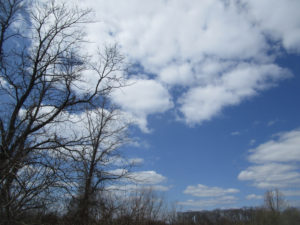
Sky above farmland in Monroe, Middlesex County.
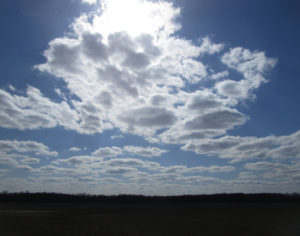
Sky above farmland in Cranbury, Middlesex County.
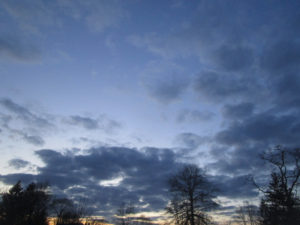
Above my backyard in Monroe, Middlesex County.
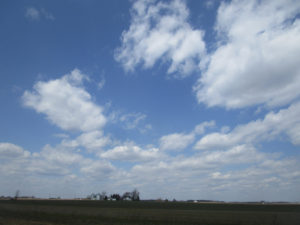
Above farmland on the Cranbury-Plainsboro boundary, Middlesex County.
SUNRISE AND SUNSET: For the week of Sunday, April 15, to Saturday, April 21, the sun will rise about 6:20 to 6:10 a.m. and set about 7:35 to 7:45 p.m.
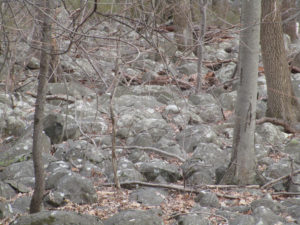
A Piedmont boulder field on the Princeton Ridge in Princeton, Mercer County. Notice the lichen growing on the rocks. Lichen is a sign of fresh air.
MOON: The next full moon is April 29, the Sprouting Grass Full Moon.
ATLANTIC OCEAN TEMPERATURE: The Atlantic Ocean temperature off New Jersey was about 46 to 52 degrees.
WEATHER: The National Weather Service office serving the Jersey Midlands is at https://www.weather.gov/phi/.
UPCOMING:
April 21, Saturday, 11 a.m. to 2 p.m., Burlington County, Southampton: The Pinelands Preservation Alliance’s 13th Annual Native Plant Sale, Alliance headquarters, 17 Pemberton Road (Route 616). More information is available from the alliance, telephone 609-859-8860 or website http://www.pinelandsalliance.org.
April 28, Saturday, 10 a.m. to 4 p.m., Middlesex County, New Brunswick: Rutgers University Ag Field Day, Cook Campus, Route 1 and Ryders Lane. More information is available at website http://agfieldday.rutgers.edu.
April 28 and 29, Saturday and Sunday, Hunterdon County, Lambertville: Shad Fest event of environmentalism, entertainment, food, crafts. More information is available at http://www.shadfest.com.
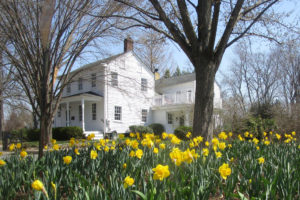
Daffodils in bloom in Cranbury, Middlesex County.
Joe Sapia, 61, is a lifelong resident of Monroe — in South Middlesex County, where his maternal family settled more than 100 years ago. He is a Pine Barrens naturalist and an organic gardener of vegetables and fruit, along with zinnias and roses. He loves the Delaware River north of Trenton and Piedmont, too.
He draws inspiration on the Pine Barrens around Helmetta from his mother, Sophie Onda Sapia, who lived her whole life in these Pines, and his Polish-immigrant grandmother, Annie Poznanski Onda.
He gardens the same backyard plot as did his Grandma Annie and Italian-American father, Joe Sr. Both are inspirations for his food gardening. Ma inspires his rose gardening.
Joe is a semi-retired print journalist of almost 40 years. His work also is at @JosephSapia on Twitter.com, along with The Jersey Midlands page on Facebook.com on the Jersey Midlands page.
Copyright 2018 by Joseph Sapia
Article by Allie Oross, photos by Johnny Malpica

Rutgers Raritan Scholars Interns Justin So and Allie Oross join New Brunswick Environmental Commission Chair Erin Connolly to hand out milkweed seeds at the New Brunswick Food Forum
On a bright morning at 10 AM in the hallways of A. Chester Redshaw Elementary School, tables from multiple community groups lined the halls in anticipation of the 7th Annual New Brunswick Food Forum organized by the New Brunswick Community Food Alliance (NBCFA). Most of the interest groups were related to food and health within the local community and, as the first visitors started to file in, it was evident that these were topics of both concern and interest. Soon the hallways were bustling with adults and children alike from the surrounding neighborhoods.
The Lower Raritan Watershed Partnership (LRWP) table was promoting the importance of pollinator plants (plants that attract pollinator species) as we handed out milkweed seeds and vegetable seedlings. Children could choose to plant their own milkweed seed at one of our tables and many of them enjoyed the opportunity to get their hands dirty.
Pollinators are animals that assist in the fertilization of plants by transferring pollen from the male anatomy of the flower to the female parts. Pollinators can include bees, butterflies, bats, and birds and are essential for plant biodiversity. The number of pollinators in an area has a direct and positive correlation with the general health of an ecosystem. When these biotic vectors rifle around within the flower looking for nectar, pollen gets stuck to their legs or bodies and when they go to the next flower they take that pollen with them. This allows for diverse genotypes within plant populations that would not be seen without the assistance from pollinators.
The LRWP’s goal in handing out milkweed was not only to encourage an increase in pollinator populations in our urban community, but to also increase public awareness and involvement. We asked that people tend to their milkweed plant and watch it grow for two months, then join us and the New Brunswick Environmental Commission for a “pollinator planting day” on Sunday June 17. At that time the plan is to plant the milkweed seedlings and other pollinator plants in New Brunswick’s Buccleuch Park Pollinator Garden. Though most of the people who visited our table were initially unsure what a pollinator was, many took an interest in the health of our environment and were enthusiastic about the prospect of taking an active role in its prospective remediation.
The ability of our environment to efficiently and cohesively function is of drastic importance to every single person that lives within it. Conveniently enough, that same environmental ability depends mostly on the decisions made and actions taken by our very own species.
As Earth day rolls around, it is vital that we reflect on anthropogenic interference in nature and take responsibility for the consequences of over-development and urbanization. If most of the damage to the planet is caused by humans, then it is a logical conclusion that humans also possess the solution. Events like the Food Forum that engage community education and interaction are integral for the remediation of our planet and decreasing the prevalence of apathy and ignorance within our population.



